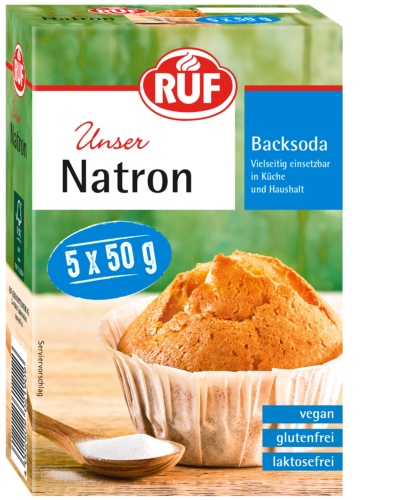Like baking powder and yeast, sodium bicarbonate is a traditional raising agent for all kinds of bakes. But what’s the difference between sodium bicarbonate and baking powder? Sodium bicarbonate (also known as baking soda) is used as raising agent, just like baking powder. However, both products are different. Sodium bicarbonate is actually an ingredient of baking powder. In baking powder, sodium bicarbonate is combined with an acidifier.
But when do you need just sodium bicarbonate or baking powder? It’s simple: if your dough is acidic, you use baking soda, not baking powder. If you want to avoid baking powder in all your bakes, then our sodium bicarbonate is also a good alternative: you can substitute baking powder with sodium bicarbonate and an acid, such as lemon juice or vinegar. The proportions are very simple. For 500 g flour, use 5 g sodium bicarbonate with six tablespoons of vinegar or lemon juice. No worries – you won’t be able to taste the acid once your bake is ready! Our sodium bicarbonate is now available in two sizes: a small 50 g pack and a 5 x 50 g pack.
For baking: Baking soda is suitable as a leavening agent for various baking recipes such as cupcakes, fluffy muffins, pancakes and cakes. To make light but stable egg whites, add a pinch of baking soda to the egg whites and whip.
For the kitchen: baking soda binds excess acidity and thus provides a mildly fruity taste as an ingredient to fruits. For this purpose, mix about 1/2 tsp. baking soda into 1 kg of fruit. Sodium bicarbonate has a softening effect and, with a pinch of a knife to 1 liter, ensures soft water. Coffee and tea thus develop their full aroma.
The prepared product contains:
| Energy (kJ) |
| Energy (kcal) |
| Fat |
| of which saturates |
| Carbohydrate |
| of which sugar |
| Protein |
| Salt |
* Reference for an average adult (8400 kJ / 2000 kcal).
Information for persons with allergies and/or intolerances
This product contains the following allergenic ingredients according to the law:
Due to our wide range of products, different articles are produced on the production lines, so that traces of certain allergens cannot be completely avoided despite careful processing:
